Mandolin Self Instructor, online tutorial - Page 25
A simplified self learning system for the Mandolin with tuning instruction, song folio, chord diagrams, sheet music and PDF for printing. By ZARH MYRON BICKFORD
| Share page | Visit Us On FB |
|
Cherry Time
Polka |
||
 |
||
|
Keys and Scales |
||
|
A KEY is a family or group of tones bearing- certain fixed relations to each other and cen-
tering around a certain fixed tone or point of repose known as the key-tone or tonic and from which the key derives its name. A SCALE is a ladder-like progression starting from the key-tone and proceeding a degree or letter at a time until the octave or key-tone has been reached again,thus requiring eight tones to complete it, while a key is distinguished or made manifest by seven tones. Since a scale is merely one of the many compositions or melodies which may be built from the tones constituting a key, these terms must not be confused. Keys are called MAJOR and MINOR ac- cording to their character. The difference in the pitch between any two tones is called an INTER- VAL, these differences or distances being measured by means of STEPS and HALF STEPS (also called TONES and HALF TONES.) The half step is the smallest interval used. All scales may be grouped under two general head-
ings-DIATONIC, those progressing letter by letter, according to the alphabet, and CHROMATIC, those progressing entirely by half steps, thus making use of all the INTERMEDIATE tones (those coming between the regular tones of the scale). The intermediate tones are represented by the aid of characters called SHARPS (#), FLATS(b) and
NATURALS (I)), the last also being oalled CANCELS. Half steps, or chromatic tones, are represented on the piano by the regular succession of black
and white keys-every key, and on the mandolin and other fretted instruments by the regular suc- cession of frets-every fret. There are two forms of the diatonic scale-major and minor. A major scale requires whole steps be- tween the first and second, second and third, fourth and fifth, fifth and sixth, sixth and seventh tones and half steps between the third and fourth and seventh and eighth tones. This order of progression must always be preserved and should be memorized, after which one can easily build a scale from any desired tone or starting point. There are two forms of the Minor Scale in modern use- HAR - MONIC and MELODIC. The Harmonic minor scale requires whole steps between the first and second, |
||